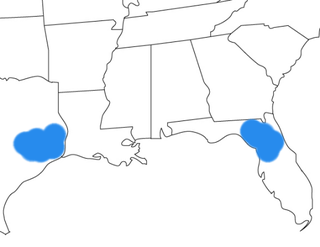
Alectrosaurus is a genus of tyrannosauroid theropod dinosaur that lived approximately 83 to 74 million years ago during the latter part of the Cretaceous Period in what is now Mongolia. It was a medium-sized, moderately-built, ground-dwelling, bipedal carnivore, with a body shape similar to its much larger relative, Tyrannosaurus rex, and could grow up to an estimated 5 m (16.4 ft) long.

Revueltosaurus is an extinct genus of suchian pseudosuchian from Late Triassic deposits of New Mexico, Arizona and North Carolina, United States. Many specimens, mostly teeth, have been assigned to Revueltosaurus over the years. Currently, three species are included in this genus, all of which were originally thought to represent monospecific genera of basal ornithischian dinosaurs. It was 1 meter long.
Orthogenysuchus is an extinct genus of caimanine alligatorids. Fossils have been found from the Wasatch Beds of the Willwood Formation of Wyoming, deposited during the early Eocene. The type species is O. olseni. The holotype, known as AMNH 5178, is the only known specimen belonging to the genus and consists of a skull lacking the lower jaws. The braincase is filled in by the matrix and most of the suture lines between bones are indiscernible, making comparisons with other eusuchian material difficult.

The Thomas Farm site is an Early Miocene, Hemingfordian assemblage of vertebrate fossils located in Gilchrist County, northern Florida.
The Ashley Formation is a geologic formation in South Carolina. It preserves fossils dating back to the Paleogene period.

Floridachoerus olseni is an extinct peccary that lived during the Hemingfordian age of the Early Miocene, and was endemic to North America. F. olseni was in existence for approximately 4.46 million years. Remains of this extinct mammal were located at the fossil rich Thomas Farm site in Gilchrist County, Florida and Toledo Bend site, Newton County, Texas. Floridachoerus olseni was named after Stanley. J. Olsen of the Florida Geological Survey in 1962. Olsen previously worked at the site for Harvard University.
Perkinsozoa is a proposed phylum in the superphylum Alveolata, which was suggested to account for the genus Perkinsus and other protist species that do not fit into existing Alveolata phyla.

Alligator olseni is an extinct species of alligator. They lived in the Early Miocene period, around 16-19 million years ago and possibly earlier. Their range was principally in what is now known as Florida, United States, and possibly extending into southeastern Texas.
Listrocerum is a genus of longhorn beetles of the subfamily Lamiinae, containing the following species:
Listrocerum maynei is a species of beetle in the family Cerambycidae. It was described by Lepesme and Stephan von Breuning in 1956. It is known from the Democratic Republic of the Congo, Angola, Gabon, and the Central African Republic.
Listrocerum quentini is a species of beetle in the family Cerambycidae. It was described by Lepesme and Stephan von Breuning in 1956. It is known from the Ivory Coast.
Listrocerum aeolis is a species of beetle in the family Cerambycidae. It was described by Thomson in 1857, originally under the genus Psathyrus. It is known from Mozambique, Ethiopia, Tanzania, Namibia, Kenya, Uganda, South Africa, and Zimbabwe.
Listrocerum apiceniger is a species of beetle in the family Cerambycidae. It was described by Stephan von Breuning in 1961. It is known from Cameroon.
Listrocerum aspericorne is a species of beetle in the family Cerambycidae. It was described by Chevrolat in 1855. It is known from Nigeria.
Listrocerum bicolor is a species of beetle in the family Cerambycidae. It was described by Lepesme in 1950, originally under the genus Combesius. It is known from Ghana, Sierra Leone, the Ivory Coast, the Central African Republic, and Togo.
Listrocerum fuscopicalis is a species of beetle in the family Cerambycidae. It was described by Stephan von Breuning in 1961. It is known from Cameroon.
Listrocerum joveri is a species of beetle in the family Cerambycidae. It was described by Quentin in 1951, originally under the genus Combesius. It is known from the Ivory Coast.
Listrocerum murphyi is a species of beetle in the family Cerambycidae. It was described by Adlbauer in 2004. It is known from Malawi.
Listrocerum psathyroides is a species of beetle in the family Cerambycidae. It was described by Lepesme in 1950. It is known from the Ivory Coast.
Crenatosiren is an extinct genus of dugongid sirenian known from the late Oligocene (Chattian) of Florida, North Carolina, and South Carolina.







